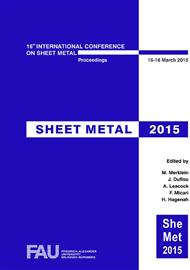p.187
p.195
p.205
p.213
p.221
p.227
p.235
p.243
p.251
Tribological Behaviour of Lubricants in Hot Stamping of AA6016
Abstract:
The increasing demand for fuel-efficient vehicles has led automotive industry to introduce new alloys in car manufacturing, characterized by a high stiffness and strength-to-weight ratio. Due to their mechanical and chemical properties, aluminium alloys appear potential candidates to replace traditional steels for several parts of the car-body-in-white, even if the limited formability at room temperature, the marked springback and the severe tribological behaviour have often represented important drawbacks in traditional properties. Recently, the use of temperature-assisted processes, such as hot stamping, allows overcoming such limits thanks to substantial increase of the formability and, at the same time, a drastic reduction of springback. However, the choice of proper process parameters, in terms of lubrication at the interfaces between the dies and the blank, and thermal parameters of the dies materials still represent critical points for the feasibility of the process. Recent investigations have proved the limits of assuming constant friction for all the areas of the dies and the steps of the deformations, especially with variable pressures and non-constant temperatures at the interfaces. Such factors, together with the lubricants and the lubricant deposition on the blank, the blank and dies coatings, the surface roughness, the stamping speed are not always considered, despite their considerable influence on the process tribology. In this paper the friction behaviour of commercially available automotive aluminium (AA6016 alloy) is studied. The friction coefficient is measured by means of a new machine for strip draw test at different levels of pressure, temperature, sliding speed and type of lubricant. The results report the investigation of the surface topography of the metal sheets, investigated by Energy-Dispersive X-ray spectroscopy and optical profilometry.
Info:
Periodical:
Pages:
221-226
Citation:
Online since:
March 2015
Authors:
Keywords:
Price:
Сopyright:
© 2015 Trans Tech Publications Ltd. All Rights Reserved
Share:
Citation:


